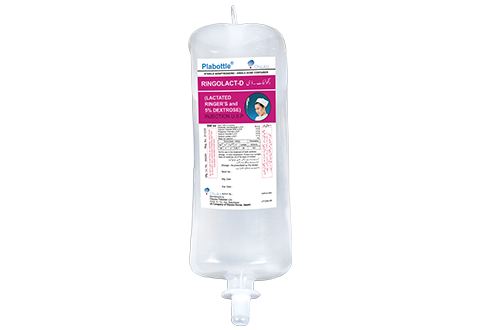
Electrolyte Solutions - RINGOLACT-D
(Lactated Ringer’s and 5% Dextrose Injection U.S.P)
Therapeutic Class
- Isotonic crystalloid solution and carbohydrate source.
Description and Composition
A clear, colorless to slightly yellowish solution, each 1000ml of which contains:
| Calcium Chloride 2H2O | 0.2 grams |
| Potassium Chloride | 0.3 grams |
| Sodium Chloride | 6.0 grams |
| Sodium Lactate | 3.1 grams |
| Dextrose Monohydrate | 50.0 grams |
| Water for Injections | q.s. |
Indications
- Hypovolemic states such as those induced by severe diarrhea and vomiting.
- Trauma and burns.
- Environmental emergencies such as severe perspiration leading to dehydration and heat illness.
- Also indicated for the prevention and replenishment of extracellular fluid before, during and after surgery.
Dosage and Administration
The dose is dependent upon the age, weight and clinical condition of the patient.
Rehydration Therapy
In severe cases of diarrhea and vomiting, Ringer’s Lactate (Ringolact) is indicated for the initial therapy and should be administered in a bolus dose of 20-30 ml/Kg.
Burns
When treating burned patients, the Parkland burn formula can be used.
Parkland Formula
4ml x %Burn x Weight (kg)
50% of this amount should be given over the 1st 8 hours post burn and the rest over the next 16 hours.
Hemorrhage
Fluid resuscitation with Lactated Ringer’s Injection for blood loss requires 3ml. of Lactated Ringer’s Injection for every 1ml. of blood loss.
Duration of Action and Excretion
Passes out of the blood stream quite rapidly, especially when normal renal function and renal blood flow are present. It is a balanced salt solution and when infused about 25% is retained in the ECF.
Adverse Effects
- Fluid overload
- Congestive heart failure.
Contraindications
- Congestive heart failure.
- Renal failure.
Precautions
- Care is required in patients with cardiac failure and severe liver damage and in cases where salt intake is restricted as the solution contains sodium chloride 6.0 grams/Liter and sodium lactate 3.1 grams/Liter.
- Caution should be exercised in patients with hypertonic dehydration, alkalosis and those having disturbances of lactic acid metabolism.
- Monitor E.C.G. continuously.
- Frequently monitor blood pressure, pulse rate and respiratory rate.
- Frequently auscultate breath sounds for rales.
Tonicity and Osmolarity
- Isotonic solution having a tonicity of 137.
- Hyperosmolar solution (550 mOsm/L) (Although the tonicity and osmolarity are slightly less, nevertheless Ringer’s Lactate is considered to be isotonic and isosmotic).
Caloric Value
- 187 kCal/Liter
Pharmaceutical Precautions
- Lactated Ringer’s Injection should not be mixed with citric acid added blood, and preparations containing phosphoric acid or carbonic acid, as the calcium content of this solution may form precipitates with these acids
- Store at room temperature. Protect from sunlight.
- Do not use if bottle is leaking, solution is cloudy or contains foreign matter.
- Discard unused portion.
- Keep all medicines out of the reach of children.
Packaging
500ml and 1000ml in Plabottle.
Pharmacological Effects
- 5% Dextrose and Lactated Ringer’s Injection has an electrolyte composition and concentration similar to that of the extracellular fluid along with added dextrose which acts as a caloric source.
- In stressful situations, e.g. surgery, provision of dextrose prevents gluconeogenesis, which otherwise occurs due to catabolism of fats and proteins.
- Provides calories for some metabolic needs. Each 100mL provides 5 grams of Dextrose and each gram of Dextrose Monohydrate provides 3.4kCal. Depending on the presence of insulin, glucose enters cells and is broken down to pyruvate. With adequate oxygen, it enters the Kreb's cycle in the mitochondria and is converted into energy (A.T.P.), CO2 and H2O. The brain does not require insulin for glucose metabolism.
- Even large volumes of infusion of the solution do not easily cause sodium excess and hyperchloremic acidosis.
- It expands circulating blood volume by approximating the fluid and electrolyte composition of the blood along with providing energy.
- Provides the following electrolytes in each liter of fluid:
Sodium 130 mEq. Chloride 108.7 mEq. Potassium 4 mEq. Calcium 2.7 mEq. Bicarbonate(as Lactate) 28 mEq. - Lactate is metabolized by the liver and converted to bicarbonate. One mole of lactate is metabolized in the body to produce one mole of bicarbonate. Therefore its administration has the same effect as that of bicarbonate.
- The presence of lactate not only eliminates any chances of dilutional acidosis, but also aids in the correction of mild acidosis.
- The infusion of Ringer’s Lactate does not induce hypokalemia and hypocalcemia as compared to normal saline.
- The pH range is 3.5 - 6.5.

